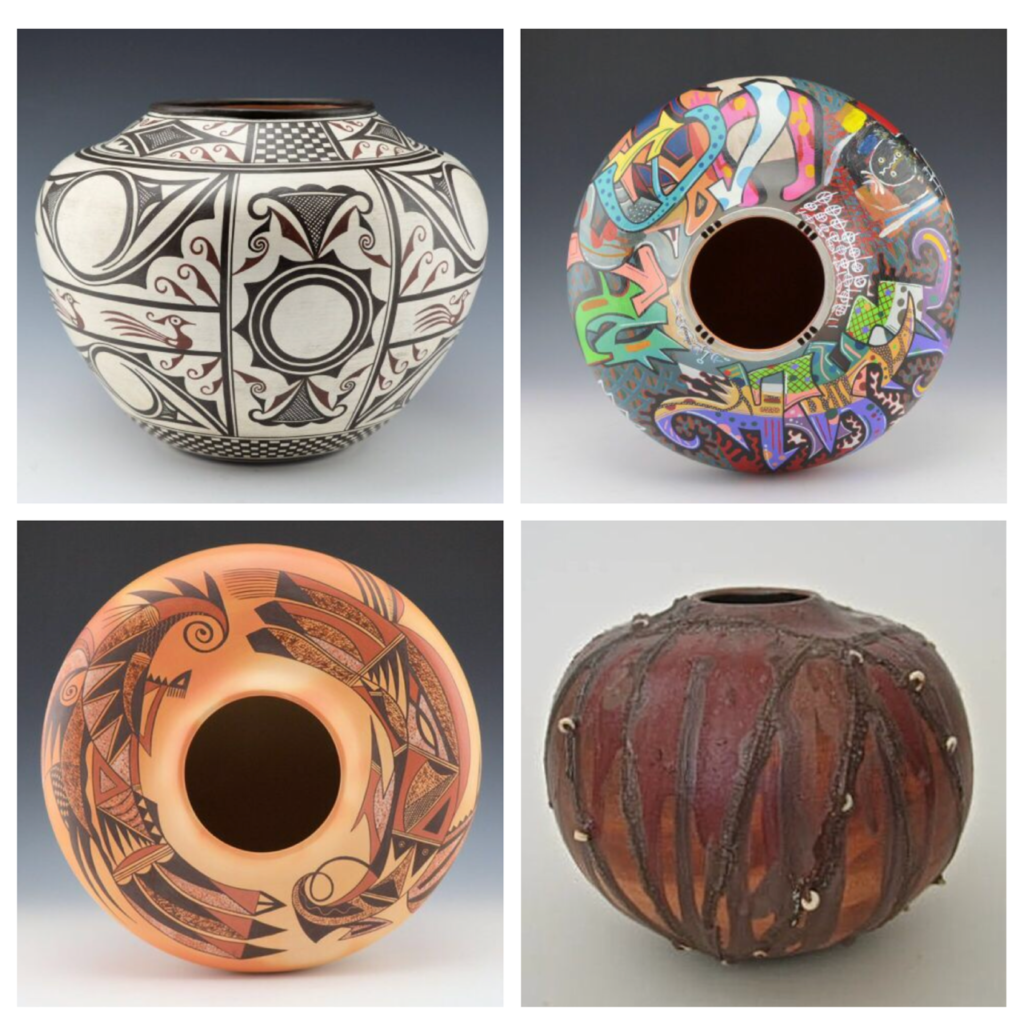Collector's Corner
EXPECT THE UNEXPECTED: The Ceramic Art of Les Namingha
Artists who continually experiment and explore hold the interest of collectors who anxiously wait to see what they will create next. Les Namingha is such an artist. It is astounding that he is able to produce so many astonishingly diverse works. Each of his pieces is unique. Mr. Namingha uses the ceramic medium much like a painter employs canvas or a sculptor stone or wood. His imagery ranges from the representational to the abstract and sometimes a combination of the two. Namingha, as well, endlessly explores the potential of the ceramic medium, blending the traditional and the contemporary in a variety of ways. Sometimes he decorates hand-coiled pots of Native clay with acrylic paints. At other times, he uses Native paints, but creates an unusual form. His work is an investigation of color, form and composition. The designs he employs are distinct, highly detailed, and precisely painted. Often they are contemporary interpretations of Hopi-Tewa or Zuni iconography, but at other times clearly show the influence of Twentieth Century Modernism.

One of Namingha’s most dazzling creations is Finesse, a work whose irregular lines and striking color combinations immediately catch the viewer’s eye. The imagery references the patterns and hues of Navajo Germantown rugs. The orange paint combined with black makes the piece particularly striking and is suggestive of orange-on-black pots created by Margaret Tafoya in the 1930s. Finesse is divided into sections of bold color – black, orange, gray, brown – each containing a dramatic design. Some are composed of jagged lines reminiscent of traditional Hopi bird wing imagery while others contain squiggles. There are also small, square sections containing tiny dots. Commenting on the pot, Mr. Namingha stated, “Finesse is about exploring the delicate nature of taper in the triangular patterns of Pueblo ‘bird wings’ and the fun looping of lines in the script-like designs, which I love painting!”
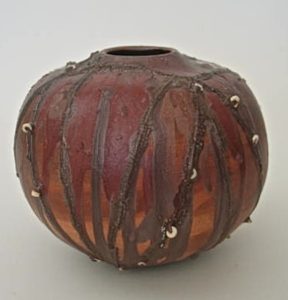
Collection of E. J. Guarino
In 2012 Les Namingha created a pot with red glaze and shells, which has a rough, raw quality. Once again, he defied expectations since the piece is a radical departure from most of his output. The work references historic as well as pre-Contact basketry, which employed small shells for decoration. Although this piece appears simple on first viewing, it is actually quite complex. In addition to the shell adornments, the artist utilized four variations on one color: thick bands of dark brown that crisscross the pot, deep reddish brown, a dark tan as well as a light tan. This pot is a shocking deviation from Mr. Namingha’s polychrome pots covered with intricate geometric designs.
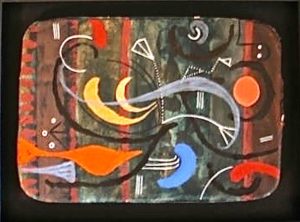
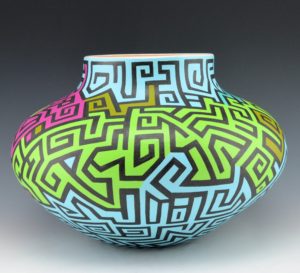 |
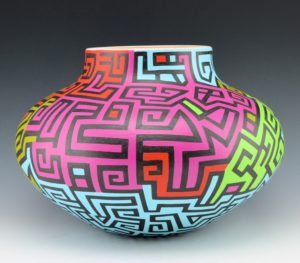
|
Namingha’s 21st Century Polychrome is a striking work that references Keith Haring’s visual language. The piece is rich in electric colors and bold lines that create shapes and patterns that play out across the surface of the jar. The vivid colors divide the piece into sections, yet produce a visual harmony with the bold lines adding to the formally balanced composition. Like much of modern painting, the piece has a flat quality not unlike canvases produced by Miro, Klee, and Matisse late in his career.
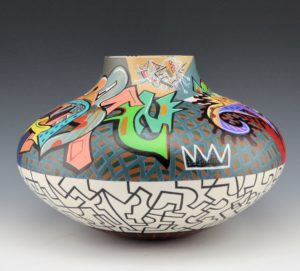 |
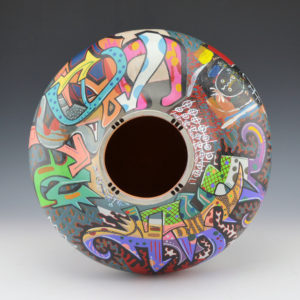 |
Urban is another of Les Namingha’s pieces that is filled with vivid colors and strong lines. The imagery immediately brings to mind graffiti seen in many urban centers, giving the impression that the jar has just been “tagged.” Across the top there is the word urban, a graffiti-style Hopi bird, as well as a katsina mask incorporated into the design. The bottom of the pot is decorated with Keith Haring inspired lines. Namingha acknowledges that, in addition to the art of Jean-Michel Basquiat, Keith Haring, Sol Lewitt, and Nampeyo, he was also inspired by the work of Jersey Joe (aka Rime), a graffiti artist known for his dramatic use of color, dynamic lettering, and comic book style characters.
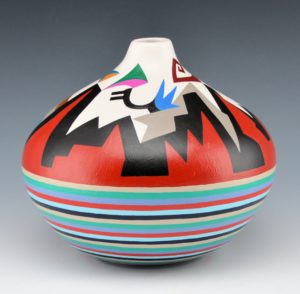 |
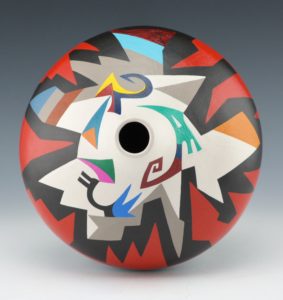 |
Vibrant colors, thick lines, and striking, abstracted imagery, are painted on the top half of Vista, a piece that is meant to suggest the many hues created at sunrise and sunset on the Hopi mesas. The artist has also surrounded the mouth of the pot with his interpretations of Hopi bird designs. One is reminiscent of Road Runner, the character from the Warner Bros. cartoon who always manages to outwit Wile E. Coyote. In the red sections, where the acrylic paint has been heavily applied, it is possible to see brush stokes, which gives the work a painterly quality. The lower portion of the pot consists of multi-hued bands, the predominant color being turquoise, which one would not expect to work with the bold red of the upper section, but it does.
 |
 |
In many of his works, Les Namingha references his Hopi-Tewa and Zuni heritage. Kiva Wall Painting takes inspiration from art created for the walls of ancient kivas. Many of these underground religious chambers contain spectacular examples of pre-contact art and are covered with paintings depicting Pueblo life and religious ceremonies, colorful symbols, and portrayals of humans, animals, lightning, rain, and katsinas. The artist was particularly influenced by the kiva wall paintings found at Awatovi and other ruin sites. The village of Awatovi, which has been a ruin since 1700, was the first of the Hopi villages to be visited by the Spanish in 1540, but it was not until 1629 that there was a serious effort to convert the inhabitants to Christianity. In that same year, the mission church of San Bernardo de Aguatubi was built over Awatovi’s main kiva. During the Pueblo Revolt in 1680 the church was destroyed. However, during the Reconquest plans were made to rebuild the mission, but by 1700 tensions between the Christian converts and adherents of the traditional Hopi religion in all the other villages exploded. Warriors set upon the Awatovi, killing all the men. Many women and children also died and those that survived were dispersed among other Hopi villages. According to Hopi oral tradition the priest at Awatovi was beheaded.
For Kiva Wall Painting, Namingha draws on representations of the Butterfly Maiden. According to the artist, “The figures depicted are actually butterfly maiden figures on flowers. Note the Hopi-style hair whorls on the figures.” The painting on the piece is a balance of muted tones for the Butterfly Maidens and strong colors – red, black, and white – for the rest of the pot. The artist has taken classic Hopi images and designs and reinterpreted them in his own unique style.
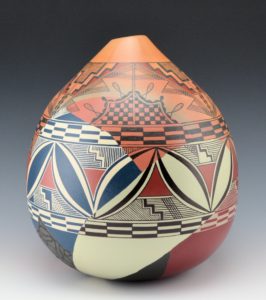 |
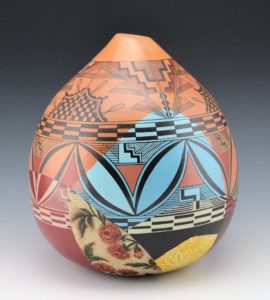 |
Blossom is technically and visually remarkable. One fascinating aspect is that it is a reconstructed ceramic. After being fired, the piece is carefully broken and then put back together using a special epoxy. They are so expertly joined that it is difficult to tell that this is a reconstructed work unless one runs one’s hand over it. Each of the sections is painted after the pot has been reassembled. Various areas are painted with traditional Hopi designs. Other ceramic artists such as Nathan Begaye, who was Hopi-Navajo, and Rick Dillingham, who was European-American, also produced reconstructed pots, which are often referred to as “shard vessels.”
The title of this ceramic vessel is highly symbolic. Like a blossom, it “opens” to reveal it’s beauty and it has multiple components that create a whole. Charles King has commented, “ . . . the name comes from the various traditional plant patterns seen on the jar. Around the neck are checkerboard agave designs surrounded by almost modernist fineline patterns. There is a checkerboard pattern around the shoulder of the piece and below larger flower designs.”
Mr. Namingha continued the flower motif in Blossom by attaching floral textiles to the surface of the piece after the firing, using an acrylic gloss gel on the fabric’s underside as an adhesive. The artist commented on this innovation by stating, “Years back, I used cloth material on some pots. I liked the results and planned on doing some more collage works at some point. Recently , my mother being a seamstress, had a nice collection of scrap cloth which led me to decide to use some of those prints, that had interesting patterns, on some tiles and pots. Most of what my mom sews together are for ceremonial purposes; men and women’s shirts and dresses for dances.”
In addition, Blossom embodies the history of Hopi pottery. The top of the piece references classic pottery, which has the famous Hopi blush. Brown-on-white sections suggest early Polacca Polychrome pottery and white-on-red areas evoke ancient pottery from the Tonto Basin. The vivid blue is a visual allusion to the artist’s work, which incorporates contemporary imagery and electric colors.
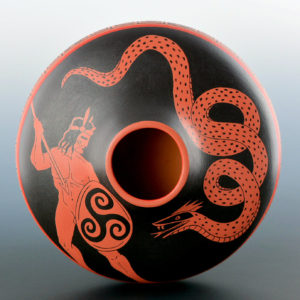 8w” x 4.5h” (2017). |
 |
Once again Les Namingha defies expectations with Cadmus and the Dragon, a work inspired by ancient Greek ceramics and mythology. The red-on-black coloration of the piece as well as its foot reference classic Greek pottery while the extremely wide shoulder is derived from Hopi pottery. Encircling the piece is a decorative border known as the Greek key design, which symbolizes infinity, the current of life, serpents, water, the four directions, and the seasons. In Greek, the design is called meandros and takes its name from the Meander River in modern-day Turkey. The most employed visual symbol in Ancient Greece, the pattern has also been an important Indigenous pattern in the Americas for thousands of years.
In Greek mythology, Cadmus is one of the greatest heroes before the time of Hercules. Cadmus was sent by his parents to rescue his sister Europa who had been abducted by Zeus in the form of a white bull. In the course of his travels, Cadmus came to Delphi, where he consulted the great oracle of Apollo who told him to cease his wanderings and follow a cow with a half moon on her side. Eventually, Cadmus came to the spring of Ares where he found the Ismenian dragon, a giant serpent, and slew it. Unfortunately, this creature was sacred to the god Ares who made Cadmus do penance for eight years.
Namingha’s representation of the myth casts the monster as benevolent Kolowisi, the feathered or horned serpent who saved the Zuni people from starvation during a great flood by regurgitating water, seeds, and meat. To Tewa people this being is called Avanyu and in Mesoamerica the feathered serpent was known as Quetzalcoatl. The artist continues his rendering of the legend by portraying Cadmus as a Pueblo warrior whose mask suggests a katsina headdress. With Cadmus and the Dragon, Mr. Namingha reinterprets the myth of Cadmus to create a ceramic work that combines Greek, Hopi, Tewa, and Zuni cultural elements.
 10.5w” x 5.75h” (2017). |
 |
In addition to his avant-garde pieces, Mr. Namingha also produces ceramics with more traditional iconography and natural paints such as his Large Jar with Pointillism Hopi Birds. Employing classic Hopi-Tewa designs and firing, the artist created a jar with an extremely wide, high shoulder, but with a very short neck. The work is painted with two highly stylized birds whose wings extend below the shoulder. Although they are quintessentially Hopi-Tewa, the artist has added his own unique touch: sections of the birds are painted with hundreds of small dots, giving the piece the look of Pointillism, a style of painting made famous by Georges Seurat, Paul Signac, and others in the late 1800s. Adding to the work’s beauty is the delicate blush created by the firing process.
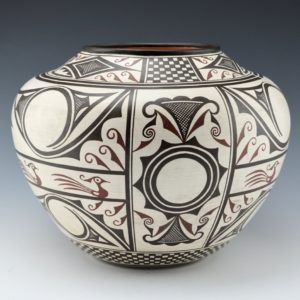
Zuni Jar with Birds & Rainbirds is another of Mr. Namingha’s pieces that has a more traditional appearance, though non-traditional acrylic paints have been employed in its creation. At first glance, the piece appears to be a traditional Zuni pot with the expected shape and motifs, but closer investigation reveals that the artist has invigorated the classic Zuni olla with a unique interpretation. The designs represent rainbirds, drawn as fineline swirls, and birds. Around the entire piece are feather patterns and two vertical bands, which contain geometric patterns. As he often does, Les Namingha has taken an archetypal form and made it thoroughly modern.
Les Namingha is one of the most exciting and innovative contemporary American artists. He continually experiments, pushing the boundaries of the ceramic medium. The diversity of his creativity is awe-inspiring, moving effortlessly between representation and abstraction. Mr. Namingha often mixes traditional techniques with contemporary materials and takes inspiration from artistic traditions as varied as his Zuni and Tewa-Hopi heritage as well as ancient Greek pottery, Pointillism, and graffiti art and artists as disparate as Nampeyo, Georges Seurat, Paul Signac, Jean-Michel Basquiat, Keith Haring, and Sol Lewitt. Mr. Namingha draws from a seemingly endless well of creativity.


